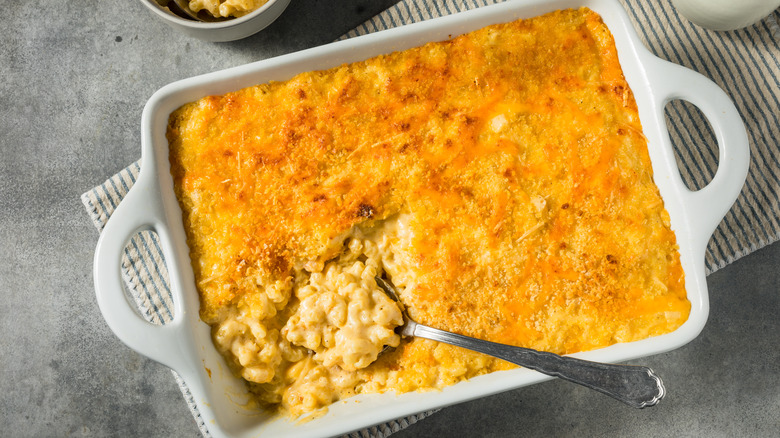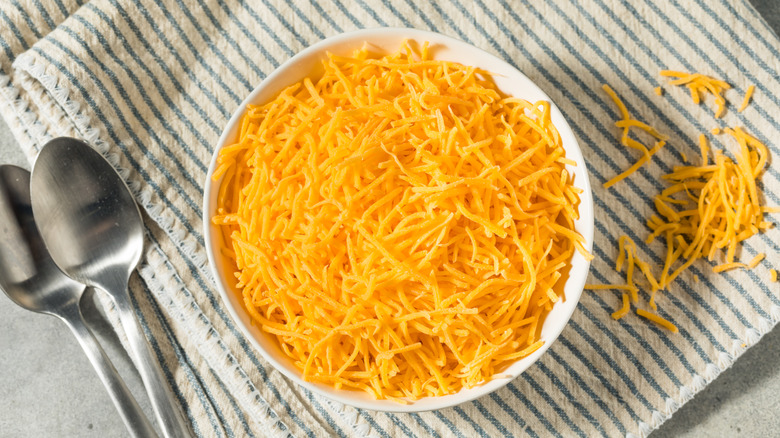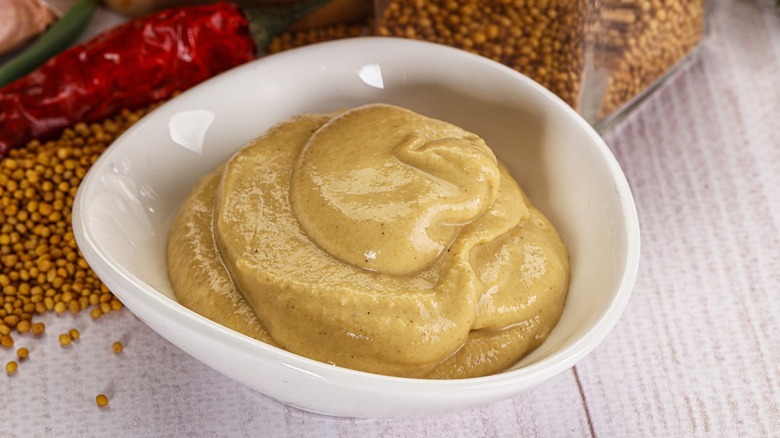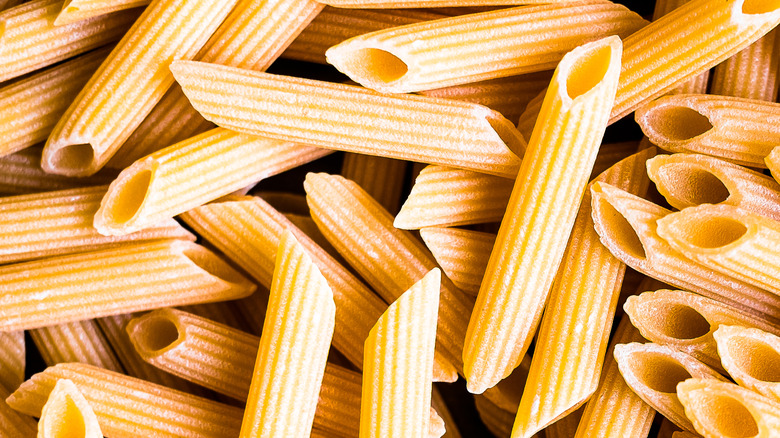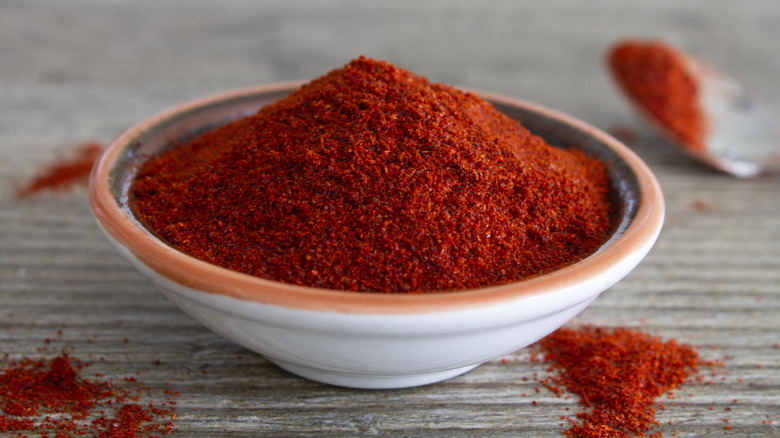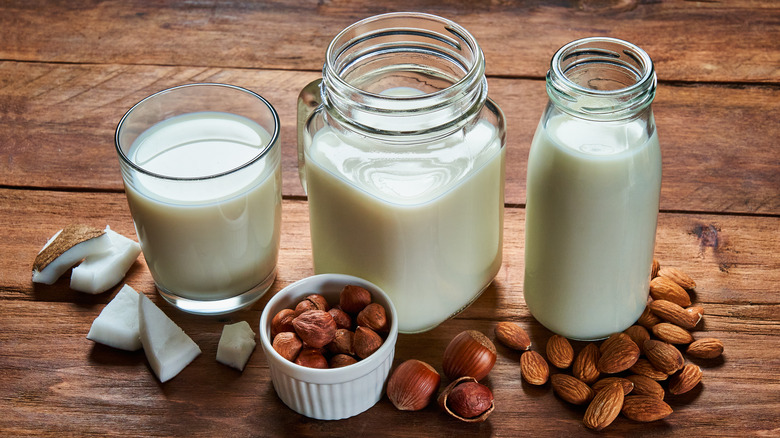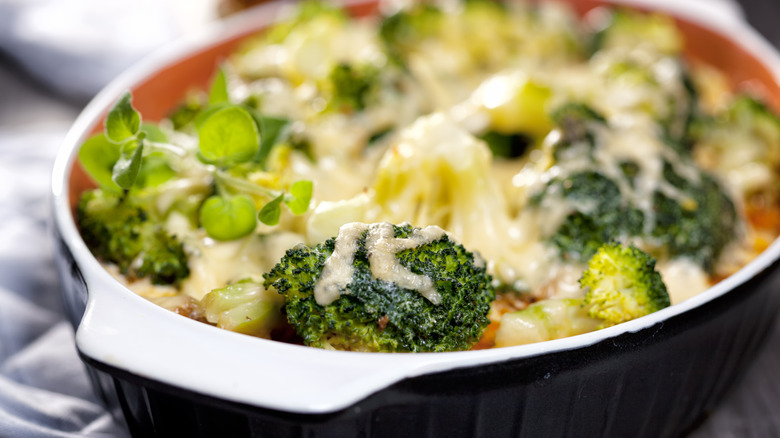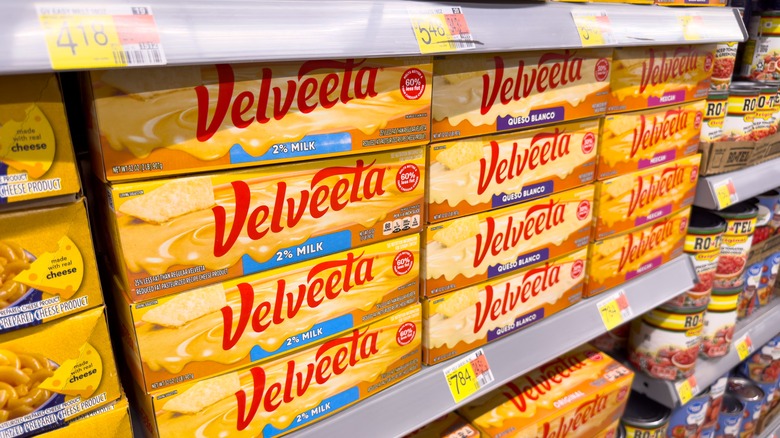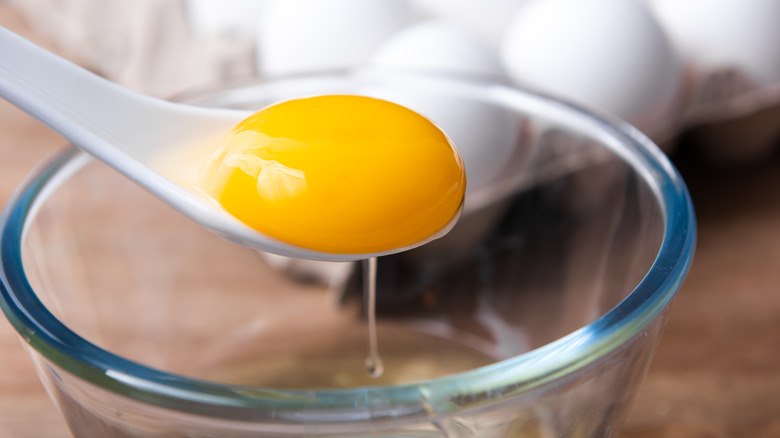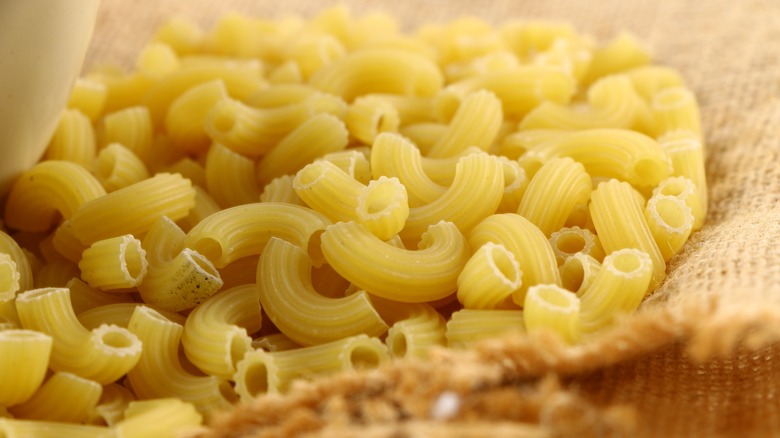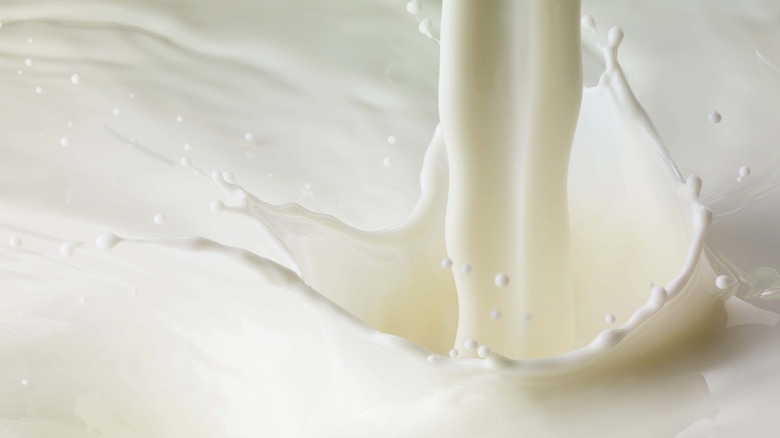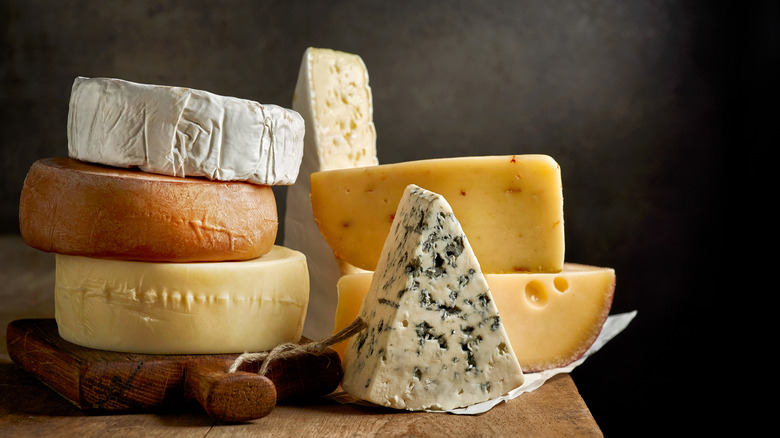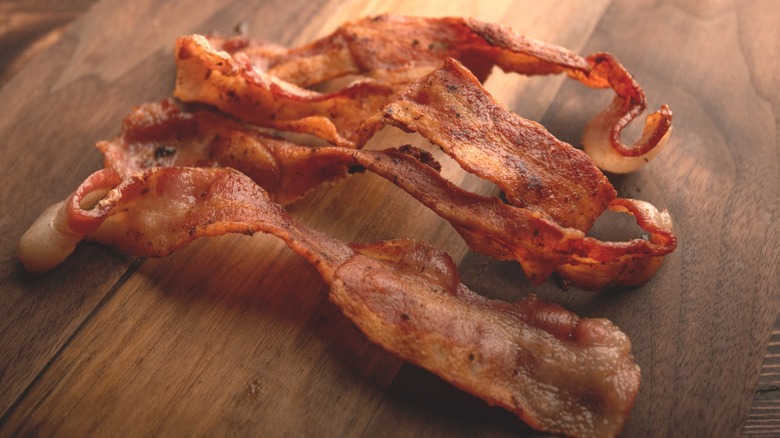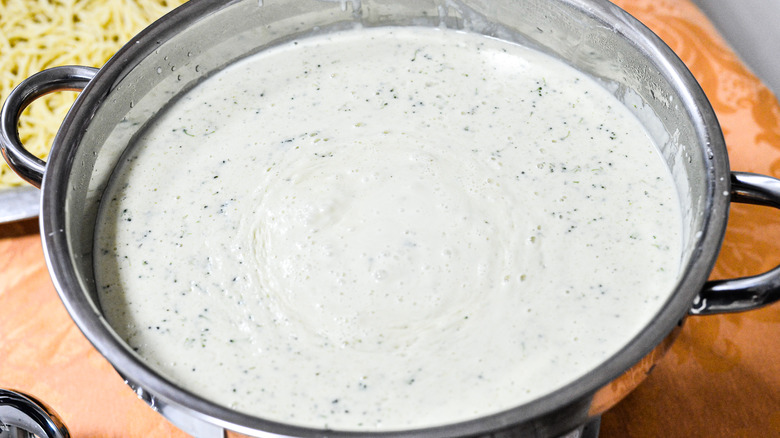5 Ingredients You Should Avoid Adding To Macaroni And Cheese And 8 To Try Instead
Macaroni and cheese is a beloved dish in American culture. After all, who doesn't love noodles covered in thick, melted cheese infused with milk and butter? And while most of us enjoy mac and cheese as is, there are times when jazzing up the ingredients doesn't seem like such a bad idea — but is it?
In the upcoming article, we're striving to set the record straight about which ingredients belong in macaroni and cheese and which do not. While subjective, we've tried to highlight the ingredients that can make your mac shine while weeding out the ingredients that might cause it to fall flat. And while not all these suggestions will work for everyone, we're confident you'll walk away with at least one new ingredient or technique to make your next mac and cheese dish that much better. Join us as we uncover the ingredients you should avoid adding to macaroni and cheese and what to try instead.
Avoid: Low-fat cheese
Though low-fat cheese can be used to make macaroni, we don't always recommend it. This sort of cheese can be more difficult to melt, which can disrupt the texture of the sauce. Low-fat cheese used on baked macaroni may even sometimes appear as separate strands rather than a uniformly gooey and delicious sheet of cheese baked on top. This not only makes your mac and cheese look a little funky, but because of its poorer melting properties, those separate strands sometimes turn into hard shards of cheese after baking — something we'd rather skip when it comes to a comforting bowl of mac.
If you must use low-fat cheese, melt it slowly. When making macaroni and cheese over the stovetop, set your range temperature to low heat as you add the cheese. Remember that your final product may be a little drier than you're used to, especially if you opt to bake your macaroni and cheese before serving. Also, if you plan to use reduced-fat versions of hard cheeses, like Parmesan, be sure to grate it finely first to assist with the melting process.
Use: Mustard
Mustard might sound like an odd ingredient to add to macaroni and cheese, but it provides a hint of tanginess that many love. Dry mustard is a type of mustard you'll find hiding in a few macaroni and cheese recipes, which offers a tangy yet subtle flavor. Just a pinch will do, as most recipes we've seen call for a teaspoon or 2, depending on the serving size.
Another common type of mustard you'll find fused with macaroni and cheese sauce is Dijon mustard. Though less commonly seen, it can be found in this one pot mac and cheese recipe along with the garlic, paprika, egg, and a blend of cheeses we mentioned earlier to yield one incredibly dynamic and undeniably tasty dish.
Like with most additions on this list, exercise caution with how much mustard you add to your macaroni and cheese. Try 1 to 2 teaspoons of dry or Dijon mustard to start, adding more as you go if needed. Adding too much might provide a little too much tanginess and thereby ruin the flavor of your dish.
Avoid: Chickpea noodles
If you've hopped on the gluten-free noodle train, you likely know all about chickpea pasta. Though a nutritious swap for traditional noodles, using this alternative in macaroni and cheese isn't always the best choice. Speaking from experience, chickpea noodles don't have the same texture as regular wheat pasta. These noodles often have a gritty mouthfeel and impart an odd flavor to the dish, making it an unsavory choice for macaroni and cheese. Adding chickpea noodles to baked macaroni and cheese is even worse; the prolonged heat exposure tends to dry the noodles out more quickly, leading to a plastic-y and almost crunchy pasta we'd rather not enjoy in our bowl of mac.
If you're looking for gluten-free noodles to use in macaroni and cheese, try rice noodles as a substitution. These are usually better as far as texture goes and tend not to impart as strong of a flavor to the macaroni and cheese sauce as chickpea noodles. If you want to use chickpea noodles or if it is the only variety you have on hand, we'd recommend using them in a creamy stove-top recipe rather than in baked macaroni and cheese. Mask any off flavors with plenty of seasonings as a distraction, as done in this spicy mac and cheese recipe.
Use: Smoked paprika and garlic
Want to take your mac and cheese to the next level? If so, try adding smoked paprika and garlic. Though salt and pepper are common seasonings for macaroni and cheese, we find that adding these jazzier ingredients helps it soar to new heights. To add these seasonings to stovetop macaroni, first make a béchamel sauce using a roux as described earlier. To the sauce, add a mixture of salt, pepper, garlic, and smoked paprika and simmer until thick to allow the flavors to develop. Continue with your recipe as you normally would; you'll end up with macaroni and cheese with a noticeably richer flavor.
Aside from smoked paprika and garlic, consider adding other spices to your macaroni and cheese to make it more interesting. Cayenne pepper provides a spicy kick, and nutmeg provides earthiness. Don't be afraid to experiment with flavors to see which you like best.
Avoid: Most milk alternatives
Milk alternatives are amazing for those who wish to avoid lactose, but using them in macaroni and cheese can get iffy. Though there are many neutral-flavored dairy-free milk varieties on the market, many have a distinct aftertaste, particularly when heated. It's worth noting that odd tastes will depend on variety and brand and may not be detectable in every case. Still, if you are using a milk alternative you've never tried before, we recommend doing so experimentally (rather than when hosting a group of people) or foregoing it completely in favor of other alternatives.
So, what other options are there? Plant-based cream works well. You could also try lactose-free milk, which is essentially milk but without the lactose. If you must reach for plant-based milk for your macaroni and cheese, try using the most neutral-tasting varieties. Look carefully at the label, as many plant-based milks come with added sugar and vanilla flavoring, which may prove unappetizing in mac and cheese. Instead, go for unsweetened plain almond or soy milk. Avoid options like coconut milk — unless you dig coconut-flavored macaroni, of course.
Use: Some vegetables
Adding vegetables isn't everyone's idea of good macaroni and cheese, and honestly, we'd only do this under certain circumstances. Classic macaroni and cheese tastes well enough on its own and tossing in veggies could potentially throw the flavor off. We get it.
Still, there's a place for vegetables in macaroni and cheese; you just have to know what kind of vegetables work best. Broccoli, for example, is a great addition to mac and cheese. Like with broccoli cheddar mini tacos or broccoli cheddar soup, this veggie and cheese flavor duo is a classic. To add broccoli, cook it alongside the macaroni noodles to tenderize before mixing it into the cheese sauce. Combine the broccoli and noodles and continue your recipe as stated. Of course, whether you use raw, cooked, or frozen broccoli matters in terms of cook time, so be sure to keep that in mind when adding it to your next mac and cheese dish.
If you aren't into broccoli, there are plenty of other veggie options to try, like peas, spinach, or even carrots and cauliflower. Ultimately, the choice is yours — just be careful with vegetables that tend to excrete a lot of liquid when cooked; these could potentially make your mac and cheese soupy, preventing you from achieving richly decadent results.
Avoid: Processed cheese
At the risk of sounding snobby, processed cheese has no place in a good macaroni and cheese dish. Yes, we know these processed cheese options are convenient, and yes, it is Dolly Parton's secret to creamy mac and cheese, but in our opinion, their use is often unnecessary. Velveeta, for instance, isn't considered real cheese, but is classified as a cheese product. And while this might not matter much to you, bear in mind that Velveeta is full of additives not found in normal cheese. Maltodextrin, sodium alginate, apocarotenal, and modified food starch are just a few found on its ingredients list.
So, what can you use instead? Making a béchamel sauce out of a roux is your best bet for achieving a thick, velvety-like consistency like that of Velveeta. Will it taste and look exactly the same? No, but that's kind of the point. This is homemade macaroni and cheese you're after, for goodness sake. A warm bowl of macaroni and cheese should take on a natural color, flavor, and texture that can comfort your very soul.
Use: Egg
Eggs aren't an ingredient that often appears in macaroni and cheese recipes, but if you know — you know. Adding an egg to your macaroni and cheese base makes the sauce richer, thicker, and creamier, all while working as an emulsifier, binding the sauce to the noodles.
To use an egg in your macaroni and cheese, you'll first need to temper it. The tempering process involves carefully heating the egg with hot liquid in a way that prevents the egg from cooking. If you were to forgo the tempering process, you might end up with scrambled egg bits in your macaroni and cheese — and no one wants that.
To temper your eggs for mac and cheese, simply add your egg or egg yolk to a separate bowl and combine with a small amount of hot liquid (i.e., your cheese mixture) as done in this one pot mac and cheese recipe. Add a little more until the egg has completely dissolved within the cheese, scrambled egg-free. Then, dump your freshly emulsified egg liquid back into the original cheese mixture and continue with your recipe. Yes, it's an extra step, and yes, adding an egg is totally optional. Still, given that it is such a simple technique for a major texture and flavor upgrade, you might consider giving it a go next time you're in the mood for impossibly decadent macaroni and cheese.
Avoid: Overcooked noodles
Overcooked noodles can ruin your macaroni and cheese experience and, believe it or not, it happens easier than you think. Overcooked noodles make their way into mac and cheese a variety of ways. Boiling your noodles too long in water is one obvious way overcooked noodles happen, but it isn't the only one. Even if you cook your noodles correctly, placing them in a baking pan and continuing to cook them in the oven can result in nearly unrecognizable noodles that can turn your mac and cheese into mush.
Another way overcooked noodles occur is during the stovetop cooking process. By boiling your noodles according to the package directions and placing them in your cheese sauce to continue cooking, you're essentially cooking the noodles twice.
So, how can you combat mushy mac and cheese? In our experience, the best method is to cook macaroni noodles for only half the amount of time specified in the package. Doing it this way ensures that any additional cooking renders the noodles exactly as want them. Remember that this tip only applies if you plan to continue cooking your mac and cheese after adding your noodles to the cheese sauce. Otherwise, you can feel free to cook up your noodles, add them to your sauce, and serve as is.
Use: Heavy cream
Heavy cream can enhance your macaroni and cheese by making it thicker and more decadent than ever before. Because of its higher fat content, it tends to yield more luxurious results than using milk alone. Having said that, you'll want to approach adding heavy cream to your macaroni and cheese with caution. Too much cream can also ruin your mac and cheese by making it a little too thick. Instead, it's best to opt for half milk and half heavy cream as prescribed in this creamy homestyle mac and cheese recipe. If you're nervous about using heavy cream, there are plenty of other heavy cream substitutes you can use.
Whole milk is a good replacement, and though it won't be anywhere near as rich and velvety, it will yield creamier results than using the typical reduced-fat milk varieties. Have sour cream on hand? A dollop or two of it in macaroni and cheese helps with richness, as well.
Use: A mixture of cheeses
Stuck in a rut using only cheddar (or the aforementioned Velveeta) in your macaroni and cheese? If so, it's time to switch things up. Though non-traditional, there are many types of cheese (and cheese combinations) you can use in your next mac dish to make its flavor come alive. Swiss is a great option for a sweet and mild taste. Provolone can add tanginess, and mozzarella, though usually associated with pizza, can be used in combination with other cheeses to add extra gooey-ness and increase that oh-so-coveted cheese pull. Other options include fontina, Gruyère, muenster, smoked gouda, and Monterey Jack.
Also, don't forget that cheddar comes in many forms. White cheddar pairs great with Gruyère as does sharp cheddar with Swiss. You could even try a blend of cheddar cheese by mixing mild cheddar with sharp cheddar to balance their flavors. There are many combinations to choose from when layering mac and cheese with cheesy goodness, so be sure to try different options according to your preference.
Use: Meat
Adding meat to your macaroni and cheese is a savory upgrade worth trying. There are countless ways to include a bit of protein in your bowl of mac that make it a more satiating and flavorful meal. Options like cured meats — think bacon, ham, or andouille sausage — provide a salty contrast against its creamy backdrop that is utter deliciousness. For a lighter take, you could even consider adding a drained can of tuna or cubed chicken breasts to your macaroni and cheese.
To add meat to your macaroni and cheese, it's usually best to precook the meat first. For stovetop mac and cheese, throw the meat in right before serving. For baked macaroni and cheese, consider adding the meat right before placing the assembled dish into the oven. For added flavor, make your cheese sauce in the same skillet you cooked your meat in. Simply drain the fat from the meat and continue with your roux, seasonings, milk, and other ingredients. The lingering taste will meld with your sauce in a beautifully subtle way that can help fuse the ingredients.
Use: A roux
Using a roux to make macaroni and cheese is common practice, but in case you aren't familiar with the technique, we'll fill you in. A roux is a blend of fat and flour used to make the base of soup, gravies, or sauces thicker. The fat used in roux is most commonly butter, though it can also be oil or other fat types. Roux is usually combined with other ingredients to make béchamel, a very versatile, thick, white sauce. And while roux and béchamel are different, both work together to create decadently creamy macaroni and cheese.
To make a roux for macaroni and cheese, start with equal parts butter and flour. Melt the butter over medium heat and add your flour. To this mixture, include your preferred seasonings. Be sure to thoroughly cook your roux to eliminate the raw flour taste, about one minute. To this, add your milk (or cream) and cook until thick. Sprinkle in your cheese and stir until uniform. Taste and adjust seasonings as needed since this will serve as the base for your macaroni and cheese. Add your noodles, top with extra cheese, bake (if desired), or simply serve as is.
